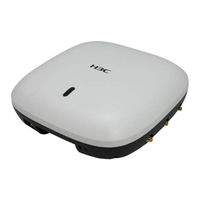User Manuals: H3C WA4300 Series Wireless Access Point
Manuals and User Guides for H3C WA4300 Series Wireless Access Point. We have 1 H3C WA4300 Series Wireless Access Point manual available for free PDF download: Fundamentals Configuration Manual
H3C WA4300 Series Fundamentals Configuration Manual (119 pages)
Brand: H3C
|
Category: Wireless Access Point
|
Size: 1 MB
Table of Contents
Advertisement
Advertisement
